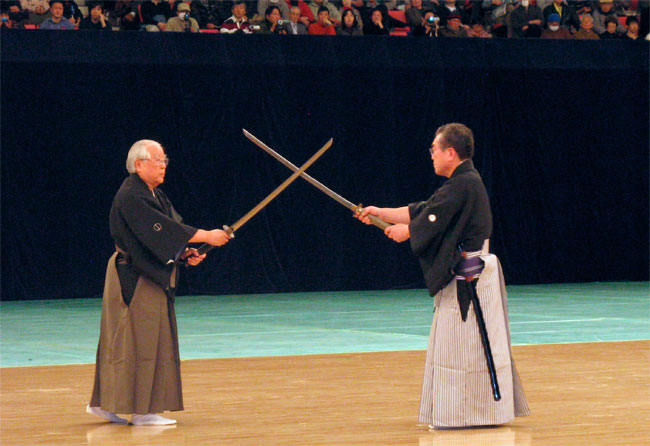The Heritage of Ittō-Ryū
 Although
Ono Tadaaki was never pitted against the likes of a
Miyamoto Musashi in combat, only a proven exemplary kenshi (swordmaster) would
be personally
selected to instruct the family and trusted retainers
of the Sei-i Tai-Shōgun. Not only was Ono Tadaaki such a
man, but several of his direct descendants continued to
instruct the elite members of the Tokugawa shogunate.
Of course, being one of the only two systems taught to
the Shōgun's closest confidants meant that its
techniques remained highly secretive. In addition,
Yagyu Munenori, the other instructor to the shogunate,
was politically astute and a personal advisor to the
Shōgun, which meant that Yagyū Jikishinkage-Ryū had a
larger following than Ittō-Ryū among the Tokugawa
retainers, despite the fact that Ono Tadaaki was
considered the
superior kenshi.
Although
Ono Tadaaki was never pitted against the likes of a
Miyamoto Musashi in combat, only a proven exemplary kenshi (swordmaster) would
be personally
selected to instruct the family and trusted retainers
of the Sei-i Tai-Shōgun. Not only was Ono Tadaaki such a
man, but several of his direct descendants continued to
instruct the elite members of the Tokugawa shogunate.
Of course, being one of the only two systems taught to
the Shōgun's closest confidants meant that its
techniques remained highly secretive. In addition,
Yagyu Munenori, the other instructor to the shogunate,
was politically astute and a personal advisor to the
Shōgun, which meant that Yagyū Jikishinkage-Ryū had a
larger following than Ittō-Ryū among the Tokugawa
retainers, despite the fact that Ono Tadaaki was
considered the
superior kenshi.
Ono Tadaaki passed Ittō-Ryū on to his sons, Ono Jirōemon Tadatsune and Ono Jirōemon Tadao, who became the second and third sōke (family leaders) of the style. The fourth sōke was Ono Tadao's son, Ono Jirōemon Tadakazu, who taught the style to the daimyō of the Hirosaki Han, Tsugaru Nobumasa (1646-1710), whose domain was located in modern day Aomori-ken in northern Japan. Three generations later, the seventh sōke, Ono Tadayoshi, taught the Ittō-Ryū system to high ranking retainer of the Tsugaru Han, Yamaga Hachirozaemon Takami. These choices to teach the system to "outsiders" would prove to be its salvation!
The Ono family died out a couple generations later, but both the Yamaga and Tsugaru families survived into the 20th century and thereby kept the art of Ittō-Ryū alive. In the mid-1890s, Sasamori Junzō (1886-1976) began training in Ono-Ha Itto-Ryu under Tsushima Kenpachi, an instructor from the Tsugaru lineage. He later spent many years training with Tsushima's successor, Nakahata Hidegoro. Following Nakahata's death, he became a disciple of Yamaga Motojiro Takatomo, the last sōke of the Yamaga line, and eventually succeeded him as 16th sōke of a reunified Ittō-Ryū. Sasamori's influence extended far beyond Ittō-Ryū, however. He played a major role in the popularisation of the sport of kendo, which was adapted primarily from Ittō-Ryū. Sasamori was one of the few kendōka ever promoted to jūdan (10th dan), and his book, This Is Kendō, published in 1964, is still considered the seminal work on the sport. His master work on kenjutsu, Ittō-Ryū Gokui ("Secrets of Ittō-Ryū) was published in 1965. In addition to his many contributions to the art of kenjutsu and the sport of kendō, Sasamori held a number of important and influential political offices, including several terms in the House of Councilors, Ambassador to the Republic of Congo, and Director of the War Reparation Agency. He was inducted into the Zen Nippon Kendō Renmei (All-Japan Kendō Federation) Hall of Fame in 2003. But it was his son who would bring Ittō-Ryū to the attention of the rest of the world.



